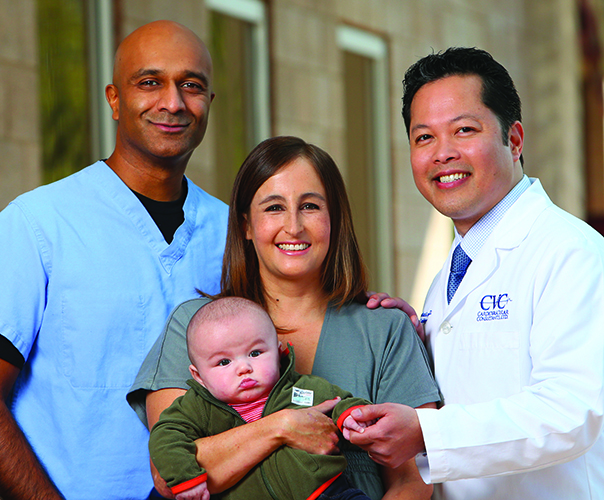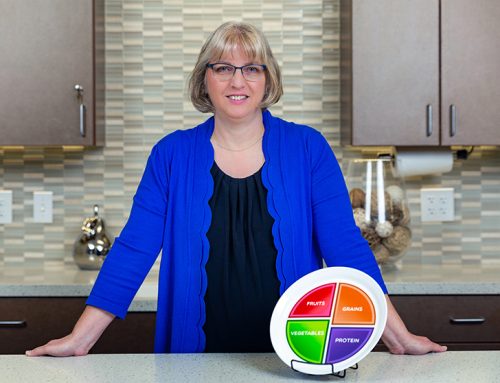Cooper was only a month old on Sept. 8, 2015, when his mother’s right coronary artery began to fray in earnest. A rare pregnancy complication, it happens once in 64,000 women, with a mortality rate of 30 to 60 percent.
For weeks, Ashley, 32, of New River, had been experiencing pain around her shoulder blades. “I had similar shoulder pain with the birth of my daughter, too,” she said. ER doctors had told her it was just her body adjusting after childbirth. “So I didn’t even tell my OB about the pain this time around,” she said.
One month to the day of Cooper’s birth, she bent to pick up her crying baby and stopped cold. Her shoulders locked from an intense burst of pain. She didn’t know it, but her right coronary artery was tearing apart.
She propped up a bottle to feed Cooper and started warming up a heating pad to treat her pain. “I began to feel nauseous, and it felt like 500 pounds on my chest with stabbing pain there and in my shoulder blades,” she said. “The pain was so bad I couldn’t talk. I texted my husband to call the paramedics. I thought I was having a heart attack.”
Trying to Breathe
It got worse. Five minutes before the paramedics arrived, cold sweats and vomiting accompanied the pain. Ashley lay on the floor with a fan blowing on her, trying to breathe. She called her husband again. “Where are they?” she begged. As he tried to calm her, the crew arrived.
Halfway to HonorHealth Sonoran Health and Emergency Center off Interstate 17, the paramedics couldn’t get Ashley’s blood pressure. The cardiologist on the phone advised the crew to head straight for HonorHealth Deer Valley Medical Center, which has a cath lab.
“I told the paramedics that with the pain I was in, I didn’t think I’d make it,” Ashley remembered. Morphine helped, and soon a roomful of doctors and nurses at the Deer Valley hospital greeted her, ready to save her life.
Cardiologist Christian Lopez, MD, examined her in the emergency department. “The initial EKG revealed evidence of a heart attack,” he said. “But Ashley’s case was atypical. She was 32; she was not diabetic or a smoker. Her EKGs showed fluctuations. At that point, I said to myself, ‘Hold the presses! Let’s wait to go to the cath lab for an angiogram. Let me figure this out.’”
Because Ashley was one month postpartum, Dr. Lopez suspected spontaneous coronary artery dissection, the tearing apart of the three layers of a coronary artery. A dissection can be caused by a genetic weakness in the artery walls and the influence of pregnancy hormones.
“It’s quite unusual, but I had seen a case like this during my fellowship,” Dr. Lopez said. Tests confirmed his diagnosis.
Stents vs. Surgery
Dr. Lopez called in interventional cardiologist Mayurkumar Bhakta, MD, to perform an angiogram. The X-ray procedure uses a narrow tube threaded through the groin to the coronary arteries to evaluate blood flow.
The angiogram revealed that Ashley’s left anterior descending artery was scarred. “It looked like the remnants of a previous heart attack due to dissection, most likely in her second pregnancy,” Dr. Bhakta said. The right coronary artery was indeed dissecting.
Cardiovascular surgeon Ken Ashton, MD, stood by in the cath lab, ready to perform open heart surgery. The vast majority of patients like Ashley go to the O.R., but he hoped that stents could prop open her artery instead. During surgery he often finds that the dissecting artery is friable — crumbly — and won’t hold sutures, he told his colleagues.
It took two tries for Dr. Bhakta to find the true opening in the collapsing artery. He then placed three of the longest stents manufactured, 38 millimeters each, into the artery. “Ashley was extremely lucky,” he said. “Cases like this usually end up in surgery.”
“It was very tense,” Dr. Lopez said. “But the stents held.”
‘We’ll Figure it out Together’
A day later, as she lay in her hospital bed, Ashley felt a mix of emotions. “I was scared but happy to be alive but a little depressed, too — I have an increased chance of having another heart attack in the future,” she said.
“The doctors and nurses who took care of me saved my life,” Ashley said. “Several doctors and nurses from the day before stopped by while I was in the hospital to see how I was. It was easy that day to get all my questions answered,” she said with a smile.
While in the hospital, Ashley called her son’s school to arrange for his transportation. She got nowhere. “My heart rate went through the roof, and one of my nurses rushed into the room,” she said. “She told me we’d figure it out together and not to be upset. Later, another staff person helped me find resources for child care for my three kids. I knew the nurses and staff cared. It meant a lot.”
After two-and-a-half days, Ashley headed home to her husband and children to recuperate.
Thirty-six cardiac rehab sessions on the Deer Valley campus strengthened her heart, along with medication to relieve the narrowing in the previously damaged left artery. A checkup with Dr. Lopez showed that the treatment plan was working.
“Believe me, I know how lucky I am,” Ashley said.






